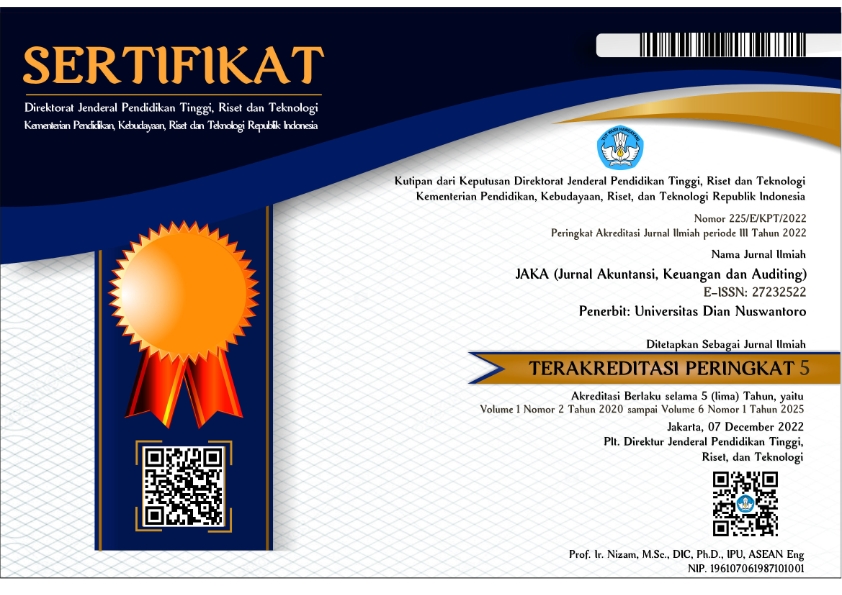HUBUNGAN EFEKTIVITAS PENGENDALIAN INTERNAL TERHADAP ENTERPRISE RESOURCE PLANNING (ERP) PADA KANTOR KONSULTAN CAMILLE SEMARANG
Abstract
ABSTRACT
Enterprise Resource Planning (ERP) is a cross-functional or information system which is for manufacturing or service company for integrated and automate business process in finance accounting and human resources in Kantor Konsultan Camille Semarang. Implementation ERP is needed for office investation to grow up the business such as performance efficiency. Basically with ERP system, a company will effective and efficient. Because company with ERP system prevented any fraud and for integrity financial report on the future. The object of this research is the consulting office in Semarang. For startup business, this is very important to used ERP to prevented fraud, because startup business mostly do not available Internal Control. Results of this research verify that ERP corelated with Internal Control effectivity in Consultant Office. This study however states that enterprise resource planning implementation has no effect on internal control effectiveness in Consultant Office. Nevertheless, the ERP implementation need to be socialized due to small number of companies implementing this software.
Keywords: Enterprise Resource Planning; Internal Control ; Consultant Office.
ABSTRAK
Enterprise Resources Planning (ERP) merupakan sistem informasi atau fungsi silang pada perusahaan manufaktur atau jasa untuk mengintegrasikan dan mengotomatisasikan alur bisnis dalam bidang akuntansi keuangan dan HRD pada Kantor Konsultan Camille di Semarang. Implementasi ERP diperlukan sebagai sebuah investasi kantor untuk membangun bisnis seperti efesiensi kinerja. Pada dasarnya dengan sistem ERP, suatu perusahaan akan efektif dan efisien. Karena perusahaan dengan sistem ERP akan mencegah tindakan kecurangan untuk integritas laporan keuangan di masa depan. Obyek penelitian ini adalah kantor konsultan Camille di Semarang. Untuk bisnis start up, penggunaan ERP sangat penting untuk pencegahan kecurangan, karena bisnis startup kebanyakan tidak mempunyai Internal Kontrol. Hasil penelitian ini membuktikan bahwa ERP berhubungan dengan efektivitas pengendalian internal di Kantor Konsultan. Pada penelitian ini menyatakan bahwa penerapan Enterprise Resources Planning tidak terbukti berpengaruh dengan efektifitas pengendalian internal di Kantor Konsultan. Namun implementasi ERP perlu disosialisasikan mengingat masih sedikitnya perusahaan yang mengimplementasikan software ini.
Kata Kunci: Enterprise Resource Planning; Internal Kontrol 3; Kantor KonsultanFull Text:
PDFReferences
Albrecht, W. S. and Romney, M. B. (1980), "Deterring White-Collar Crime in Banks", The Bankers Magazine 163: 60.
Ani, Yuan Nur, and Irni Yunita. 2015. “Analisis Perbandingan Kinerja Keuangan Sebelum Dan Setelah Penerapan Enterprise Resource Planning (ERP) Pada Bank Central Asia, Tbk dan Bank Negara Indonesia, Tbk Periode Tahun 2001- 2009.” E-Proceeding of Management 2 (2): 1392–99.
Blaszczynski, A. and McConaghy, N. (1994), "Criminal Offences in Gamblers Anonymous and Hospital-treated Pathological Gamblers", Journal of Gambling Studies 10, 99–127.
Coffin, B. 2003, “Trends in corporate fraud”, Risk Management, Vol. 50 No. 5, p. 9.
COSO, 2004, “Enterprise Risk Management – Integrated Framework”,
Committee of Sponsoring Organizations, available at: www.coso.org/Publications/ERM/COSO_ERM_Executive Summary.pdf
Clarence, Y. K. N. (2005), "White-Collar Crime is on the Rise in Malaysia, with Perpetrators Becoming More Sophisticated. Are Our Laws Sufficient Deterrents?", AsiaViews. Edition: 07/II/Feb/2005.
Crofts, P. (2002), Gambling and Criminal Behaviour: An Analysis of Local and District Court Files. Sydney: Casino Community Benefit Fund.
Galy, Edith, and Mary Jane Sauceda. 2014. “Information & Management PostImplementation Practices of ERP Systems and Their Relationship to Financial Performance.” Information & Management 51 (3). Elsevier B.V.: 310–19. https://doi.org/10.1016/j.im.2014.02.002.
Goldstraw, J., Smith, R.G. and Sakurai, Y. (2005), "Gender and Serious Fraud in Australia and New Zealand", Trends and Issues in Crime and Criminal Justice 292. Australian Institute of Criminology: Canberra.
https://www.hashmicro.com/id/blog/apa-itu-erpsoftware/ #industri
Hery (2004), “Persepsi Top Executive (Sektor Publik dan Swasta) terhadap Fungsi Internal Audit”, Journal Media Riset Akuntansi, Auditing & Informasi,Vol. 4, No. 1 April 2004:23-41.
Ikatan Akuntansi Indonesia, Standar Profesional Akuntan Publik, 2006. Jakarta: Salemba Empat.
KPMG Forensic, 2004, “Fraud Survey 2004”, KPMG International, Amsterdam.
Marden, R. dan Edwards, R. 2005, “The Sarbenes-Oxley’Ax’”, The CPA Journal, Vol. 75 No. 4, pp. 6-10.
Miles, M.B & Huberman A.M. 1984, Analisis Data Kualitatif. Terjemahan oleh Tjetjep Rohendi Rohidi. 1992. Jakarta : Penerbit Universitas Indonesia.
Mulyadi (2002), Auditing, Edisi 6. Network for Assessing the Risk of Fraudulent Financial Reporting", Managerial. Auditing Journal 18: 657–665.
Schnatterly, K. 2003 Increasing Firm Value through Detection and Prevention of White-Collar Crime, Strategic Management Journal, 24, 587-614.
Seetharaman, A., Senthilvelmurugam, M. and Periyanayagam, R. 2004, Anatomy of Computer Accounting Frauds, Managerial Auditing Journal, 19, 1055-1072.
Sudirman. 2013. “Pengaruh Implementasi Sistem ERP (Enterprise Resource Planning) Terhadap Kualitas Informasi (Studi Kasus Pada PT. Jasa Marga (Persero) Tbk. Cabang Purbaleunyi).”
Supriyanto, Agus. 2006. Banyak Perusahaan Buat Laporan Keuangan Ganda. Diakses: http://www.tempo.co/read/news/2006/07/31/05680947/Banyak-Perusahaan-BuatLaporan-Keuangan-Ganda.
Tuanakotta, T. M. (2007). Akuntansi forensik dan audit investigatif. Jakarta: Fakultas Ekonomi Universitas Indonesia.
Wibisono, Arif Fajar. 2013. “The Impact ERP System Implementations on Earning Management and Timeliness Financial Statement (Empirical Studies on Adopters SAP in Indonesian Stock Exchanges),” 106–16.
Ziegenfuss, D.E. 2001. “The Role of Control Environment in Reducing Local Government Fraud”, Journal of Public Budgeting, Accounting and Financial Management (13:3), pp. 312-324.
DOI: https://doi.org/10.56696/jaka.v3i1.6641
Article Metrics
Abstract view : 508 timesPDF - 431 times
Refbacks
- There are currently no refbacks.








